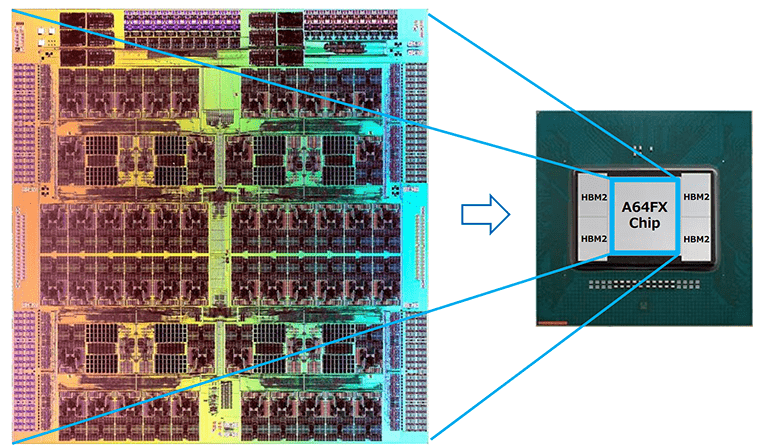
Supercomputer: “Fugaku” achieved four crowns in a row: Japanese SIMD technology
-Three times faster than the US Summit-
In the supercomputer world ranking, “Fugaku” won the four crowns for the second consecutive term.
“TOP500”:
1st place Japan Fugaku recorded 442 peta flops.
Second place US Summit has a record of 149 petaflops,
The speed is about three times that of the US Summit.
The overwhelming strength of “Fugaku” has several aspects.
Fugaku emerged due to external factors:
Development of next-generation machines in the United States and China has been delayed.
The relative strength of Fugaku seems to stand out,
Development in both the US and China is difficult:
Currently, both the United States and China are developing an “Exascale” scale next-generation supercomputer that corresponds to 1000 peta.
However, both the United States and China seem to be having difficulty.
The main reason for this is trade regulation between the United States and China and the battle for technological hegemony.
Realization of Exa Flops:
To realize a supercomputer that performs “100 kyo times per second” floating point arithmetic
“Basic architectural innovation”
At the same time
“Implementation of ultra-high-speed processor (semiconductor)”
Advanced manufacturing technology is indispensable.
Manufacturing of state-of-the-art semiconductors is indispensable.
World’s most advanced Taiwan “TSMC”:
The world’s most advanced foundry is now Taiwan “TSMC”
“TSMC” can manufacture semiconductors such as CPUs with a process rule (minimum processing size) of 5 to 7 nanometers.
RIKEN / Fujitsu joint team:
The production of the CPU “A64FX” installed in Fugaku was outsourced to TSMC.
What is a foundry?
A manufacturer that specializes in manufacturing semiconductors without developing them.
All US plans to develop on their own:
The next-generation supercomputer “Aurora” will be delivered to the Argonne National Laboratory of the US Department of Energy.
Intel has received an order for its design and development.
It plans to manufacture CPUs at its own factory in the United States.
In other words
Without outsourcing to TSMC
From CPU development to manufacturing
decided to do it in the United States.
This is the policy of the US government.
The reason is probably China in mind.
For Taiwanese manufacturers like TSMC
If you entrust the manufacturing of the core parts of the supercomputer,
When tensions increased between China and Taiwan
The United States will not be able to receive parts supply,
Because there is a fear.
US Intel lags behind in manufacturing technology:
In recent years, Intel has been behind TSMC and Samsung’s overseas companies in semiconductor manufacturing technology.
At this time, it is not possible to manufacture CPUs with a minimum machining size of 5-7 nanometers.
This is considered to be the main reason why the development of next-generation supercomputers of the Exa class is delayed as a result.
China cannot manufacture next-generation CPUs:
China is suffering from trade restrictions imposed by the US government.
Last year, a Chinese supercomputer maker was added to the US Department of Commerce entity list.
China is no longer able to build CPUs using US technology.
China may have reached a level where it can independently develop exa-class CPUs.
However, even if that is the case, the production cannot be completed domestically.
Because, there is a foundry called “SMIC” in China.
However, “SMIC” does not have manufacturing technology comparable to TSMC.
Legcuffs for development for political reasons:
After all, the next-generation supercomputers being developed by both the United States and China are in a situation where development has been hampered for political reasons.
This is an external factor that creates the relative superiority of Fugaku.
Japanese SIMD technology: appeared on the front stage
SIMD is also a technology traditionally a specialty of Japanese manufacturers.
NEC’s “Earth Simulator” is a representative of SIMD type supercomputers.
PreferredNetworks (PFN):
The “MN-3” developed by Japan’s Preferred Networks (PFN) is also equipped with a SIMD-type processor “MN-Core”.
The world ranking of supercomputers announced the other day.
With the “Green500” competing for its power consumption performance
“MN-3” ranked second (previous June, ranked first)
PFN has recently hired leading researchers and engineers in the field of HPC (High Performance Computing) to develop MN-3.
SIMD type high-speed calculation technology:
Perhaps Japanese traditional technology is being used by PFN supercomputers.
Japanese supercomputers such as Fujitsu and PFN almost monopolize the top of the world.
In other words, it seems that “the high-speed calculation technology such as SIMD that Japan has cultivated so far” has been greatly influenced by “the fact that it has come here and has been revived.”
Hyundai Business | Kodansha